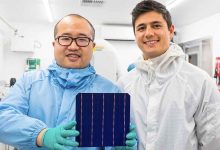Australian start-up SunDrive, backed by tech billionaire Mike Cannon-Brookes, has claimed another solar cell efficiency record, reaching the milestone 26 per cent mark for a full area commercial size solar cell for the first time.
The new record of 26.07 per cent was revealed in a LinkedIn post late on Thursday, and it comes just a few months after SunDrive’s technology claimed a world record of 25.54 per cent for commercial-size silicon solar cell efficiency, overtaking the previous record held by China solar giant Longi.
“SunDrive is proud to announce that we have successfully reached another major milestone by surpassing the 26% efficiency mark for a full area commercial size solar cell,” the company said in its LinkedIn posting.
“A huge moment for the team as we continue to push the boundaries of what’s possible.”
SunDrive was spun out of the University of New South Wales and has been backed by Cannon-Brookes and the Australian Renewable Energy Agency, which gave it $9 million in grant funding in 2020 to develop a “new breed” of solar cells designed for Australian rooftops.
SunDrive’s technology replaces the growing use of silver in solar cells – a key barrier to the broader adoption of next generation technologies – with copper, which is significantly cheaper and more readily sourced.
The concept was originally developed by SunDrive CEO Vince Allen during his PhD at UNSW. Allen then went on to found SunDrive in 2015 with his flatmate from his undergraduate studies, David Hu.
The significance of the shift to copper from silver was highlighted by a series of tweets by Allen on Friday, who noted that only two companies in the world had achieved 26 per cent solar cell efficiency.
“One is Longi (head count ≈ 50 000, revenue ≈ $10B, market cap ≈ $100B) and the other is SunDrive (head count = 15, revenue = $0, market cap as of last round <$100m). A key difference is that SunDrive uses copper, not silver,” he said.
“A 0.53% jump from our 25.54% world record efficiency in Sep 2021 is big in the solar world.
“Here’s why: (i) the practical efficiency limit is only ~27% (theoretical limit ~29%) and (ii) improvements become increasingly more difficult as efficiencies approach this limit.”
Allen said manufacturers have realised today’s mainstream PERC technology has hit its efficiency limits and see Topcon (also known as passivated solar) or HJT (heterojunction technology) as the next generation.
But he noted that those assumptions were defined by the use of silver in the solar cells. SunDrive has developed ‘supercharged’ HJT with no silver, he said, and so is not constrained by the same limits.
Half of the cost of converting a wafer into a solar cell comes from silver. And 20 per cent of silver production already goes to solar cell production, so if solar production was to increase five times – as many predict – then that will cause major supply issues.
“We can improve the efficiency above and beyond what can be achieved with silver,” Allen says. And as an added bonus, copper is 100 times cheaper and five times more abundant.
This is significant because it means more power can be generated per metre squared on people’s rooftops, and that is and will be important in a world with more distributed energy, more battery storage, and more electric vehicles.
There is a great video explanation from Allen that can be found here (produced before the latest record).










